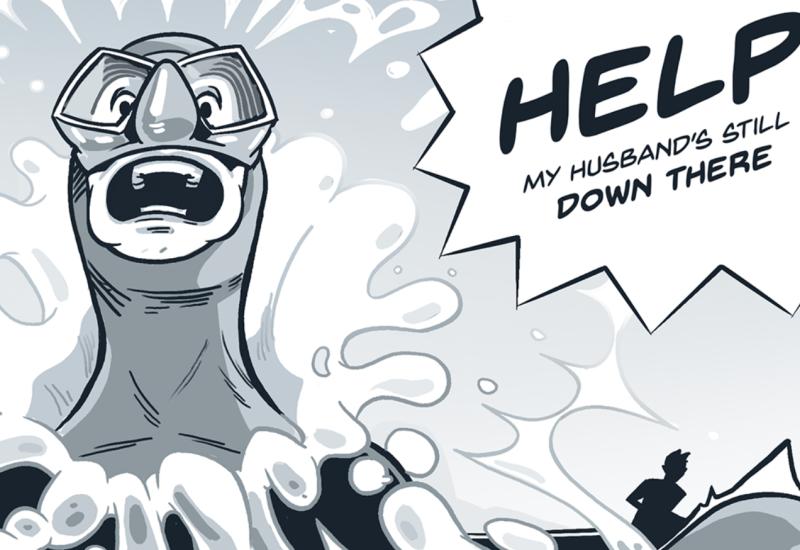Diving with Braces or Invisalign? Here’s What You Should Know

Shutterstock.com/TheVisualsYouNeedYes, you can dive with braces or Invisalign, but there are a few tips to follow.
Ever wondered if orthodontics could affect your diving? Well, good news—for the most part, diving with orthodontics requires little foresight, and isn’t all that different from diving without them says Dr. Pourang Rahimi, an orthodontist who treats patients at the Cayman Islands’ Smile Dental Clinic. Still, you’ll want to keep the following recommendations in mind on your next dive.
Make a Plan for Your Aligners
With traditional braces, divers don’t have the option of removing their orthodontic treatment ahead of a dive, “but with Invisalign, people always have the option,” says Rahimi.
For Invisalign treatments to work, patient should wear their aligners—the clear plastic trays used to adjust the patient’s teeth—between 20 and 22 hours per day. Whether a diver decides to dive with or without their Invisalign aligners, however, is up to them, Rahimi adds, as “[diving] for a half hour or 45 minutes is not going to affect their treatment significantly.”
It’s always worth your while consulting an orthodontist ahead of time to determine which option is best for your treatment plan, but if divers don’t want to remove their Invisalign aligners ahead of a dive, that’s usually okay—Rahimi says divers can comfortably wear aligners without any issues while using a regulator. Many divers, like PADI diver Sabrina Stankewitz, choose to dive with their aligners.
“I’ve always dived with them in,” said Stankewitz. “My orthodontist told me to wear my aligners while diving, and I haven’t had any problems.”
Add These Items to Your Dive Kit
If you’re diving with traditional braces or Invisalign, you’ll want stack your gear bag with more than the usual towels, water, and gear items ahead of your next dive. By bringing an aligners case on board, Invisalign patients can reduce the risk of aligner loss or damage when removing their trays while on board. Some divers suggest packing fresh water for rinsing their aligners after a dive to rinse off salt and bacteria, as well as a toothbrush and toothpaste to use after lunch and before inserting the aligners to keep them clean.
As for divers with braces, biting down on a mouthpiece for up to an hour at a time can get a little uncomfortable, says Rahimi. Avoid biting down too hard on the mouthpiece to not put too much pressure on the teeth. To ease any discomfort that arises from increased pressure on the upper lip, consider packing orthodontic wax and applying it where needed. While the chances are quite rare that braces could tear at the mouthpiece or snag within it, wax is a great way to protect yourself from snags and your equipment from tears.
Spacing out the time between your last adjustment and your next dive trip can reduce the odds of tooth discomfort and pain during the dive. Stankewitz recommends keeping your lips hydrated between dives.
“I don’t know why, but my lips dried out so fast [during my Invisalign treatment],” she says. “Buy chapsticks—a lot!”
Rinse Your Aligners After Pool Sessions
Pool sessions are an important part of many PADI experiences and certifications, including the PADI Discover Scuba Diving program, PADI Open Water Diver program, and PADI Dive Master program. But if you’re training in the pool while completing an Invisalign treatment, you’ll want to rinse your aligners, as well as your mouth, thoroughly afterwards. That’s because extended exposure to chlorinated water, which is acidic, can cause tooth erosion. When left to gather in the aligner tray, this acidic water can be absorbed by your teeth and cause damage to them.
“Like we tell our swimmers, [in] the same way that you wouldn't want to drink sugary drinks while you have your Invisalign in, it's okay to wear your trays while you're swimming,” says Rahimi. “But when you come out, take them out and rinse them.”
Follow Your Orthodontist’s Recommendations
Every patient, and treatment plan, is different. Ahead of a dive, consult your orthodontist and ask if they have any recommendations specific to your treatment plan of how to prepare for your dive. If your orthodontist is a diver, ask if they can recommend any mouthpieces, such as a cushioned mouthpiece, that make diving with orthodontics more comfortable.










